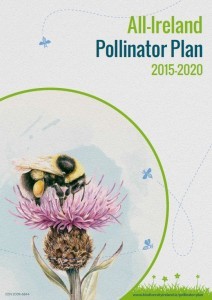September 17th 2015 sees the launch of the All-Ireland Pollinator Plan, which identifies actions to help protect pollinators and the livelihoods of farmers who rely on their invaluable pollination service.
Sixty-eight governmental and nongovernmental organisations have agreed a shared plan of action to tackle pollinator decline and make Ireland a place where pollinators can survive and thrive.
The All-Ireland Pollinator Plan 2015-2020, published today, makes Ireland one of the first countries in Europe with a strategy to address pollinator decline and protect pollination services. The initiative has generated huge support and has culminated in agreement to deliver 81 actions to make Ireland more pollinator friendly. http://www.biodiversityireland.ie/pollinator-plan. The Plan identifies actions that can be taken on farmland, public land and private land. These include creating pollinator highways along our transport routes, making our public parks pollinator friendly and encouraging the public to see their gardens as potential pit-stops for our busy bees.
It is also about raising awareness on pollinators and how to protect them. With the support of organisations like An Taisce Green-Schools, it aims to ensure that everyone, from schoolchildren to farmers, gardeners, local authorities and businesses, knows what pollinators need and which simple cost-effective actions they can take to help. The Plan will also support Ireland’s bee-keepers in keeping our Honeybees healthy.
“Unfortunately, Irish pollinators are in decline, with one third of our 98 bee species threatened with extinction,” said Dr Úna FitzPatrick from the National Biodiversity Data Centre, who chaired the Plan steering group. She added “bees are declining because we’ve drastically reduced the areas where they can nest and the amount of food our landscape provides for them.”
If you’re a pollinator, finding enough food is the biggest challenge you have to face. Declines in wildflowers are subjecting our pollinators to starvation. Fertiliser application has resulted in increased crop yields, but in strong declines in wild flowers in managed field and in adjacent semi-natural habitats. Our tendency to tidy up the landscape rather than allowing wildflowers to grow along roadsides, field margins, and in parks and gardens is also playing a big part in fewer of these resources being available.
The Pollinator Plan is not just about protecting bees but also about protecting the livelihood of farmers and growers who rely on their ‘free’ pollinator service, which allows consumers to buy Irish fruit and vegetables at an affordable price. This service is worth over £7 million per annum for apples in Northern Ireland, and €3.9 million for oilseed rape in the Republic of Ireland. It’s not just crops; about three-quarters of our wild plants also require insect pollinators. Without pollinators the Irish landscape would be a very different and much less beautiful place. The value of pollination to tourism and branding our produce abroad is enormous, but has never been assessed in a monetary sense.
Dr Jane Stout, Associate Professor in Botany at Trinity College Dublin, who co-chaired the group, added: “If we want pollinators to be available to pollinate our crops and wild plants for future generations we need to manage the landscape in a more sustainable way and create a joined-up network of diverse and flower-rich habitats as well as reduce our use of chemical insecticides. This doesn’t just mean in the countryside, but in our towns and villages as well.”
Responsibility for delivering the 81 actions has been shared out between the supporting organisations, which include the Department of Agriculture, Food & the Marine, Department of Agriculture and Rural Development, Teagasc, Bord Bía, Northern Ireland Environment Agency, Heritage Council, Fáilte Ireland, An Taisce Green Schools, Federation of Irish Beekeepers’ Associations, Iarnród Éireann, National Trust, RSPB, Tidy Towns, Transport NI, Ulster Farmers’ Union, Ulster Wildlife and Waterways Ireland.
The National Biodiversity Data Centre will track success in the Plan by measuring increases in the abundance and diversity of pollinators within the Irish landscape as the 81 actions are implemented. “Having 68 organisations voluntarily sign up to this Plan signifies its importance, and that the will to make it succeed is there” said Fitzpatrick.
In coming together to protect pollinators, we will also protect the livelihood of farmers and growers who rely on their free pollinator service, as well as improving the general health of our environment. If successful, this Plan will ensure that Ireland is a much better place for pollinators by 2020.



